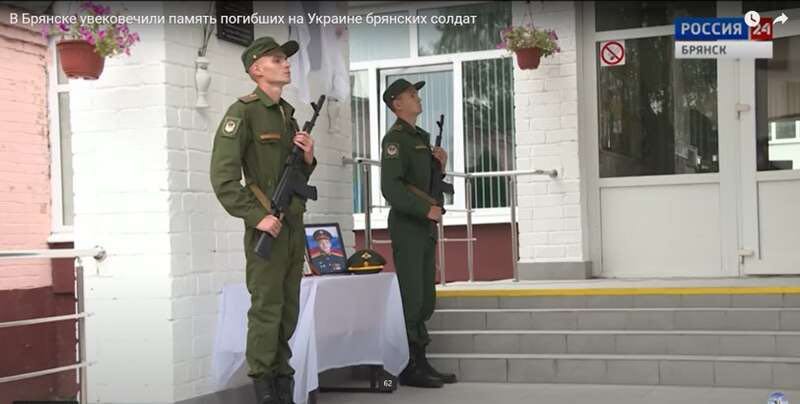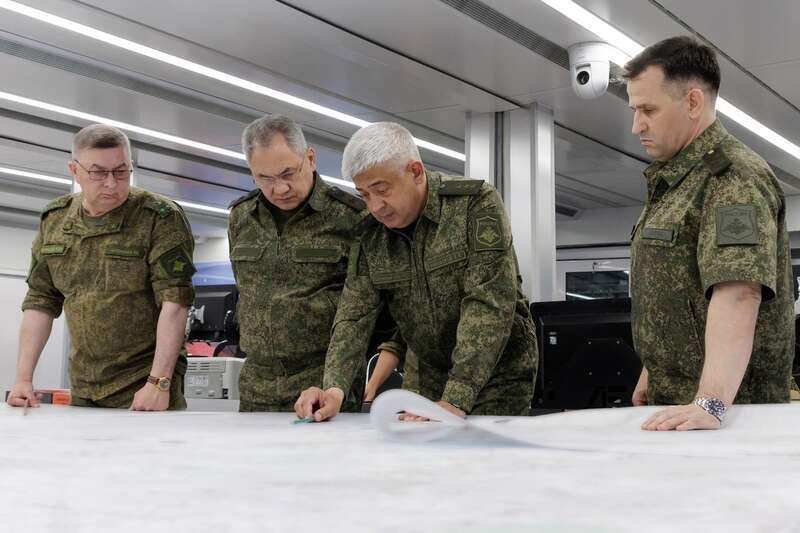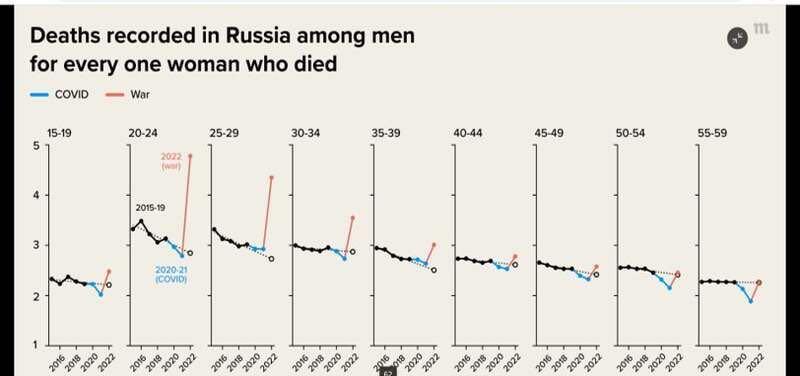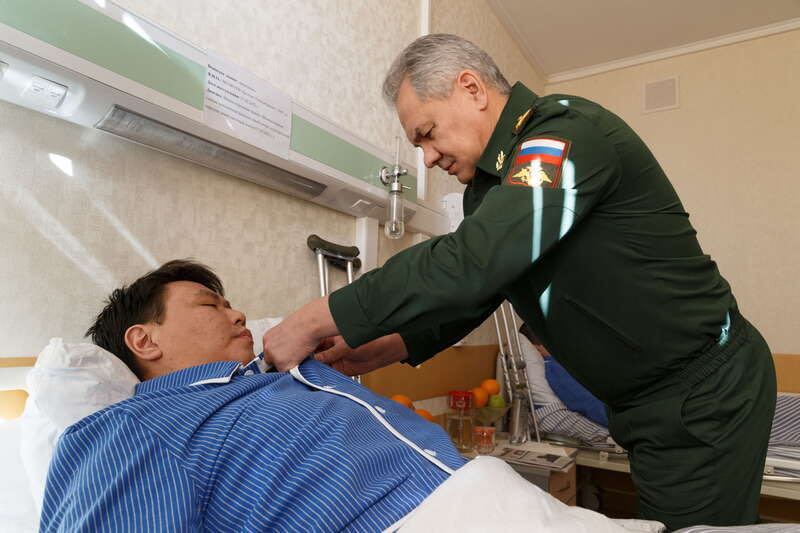New data show what the Russian authorities try to hide. A joint investigation by independent Russian news outlets Meduza and Mediazona reveals the true number of Russian soldiers killed so far during the invasion of Ukraine. At least 47.000 Russian soldiers died fighting in Ukraine and the real number is probably even much higher. The last time officials mentioned how many casualties Russia in Ukraine has suffered was in September 2022. Back then Russian defence minister Shoigu said that 5,937 Russian soldiers had died.
 Funeral of Russian soldiers from Bryansk who died in Ukraine. Screenshot Rossiya 24.
Funeral of Russian soldiers from Bryansk who died in Ukraine. Screenshot Rossiya 24.
Roughly 47,000. That is how many Russian soldiers have died so far in the full-scale invasion of Ukraine, according to a joint study by journalists at Meduza and Mediazona and Tubingen University statistician Dmitry Kobak. Analyzing existing reports about published obituaries, mortality data from the Federal State Statistics Service, and extensive records from the National Probate Registry, we estimate that between 40,000 and 55,000 Russian men under the age of 50 died fighting in Ukraine by May 27, 2023.
When factoring in the number of men wounded so seriously that they did not return to military service, Russia’s total casualty count rises to at least 125,000 soldiers, based on our calculations. (This figure does not include missing or captured soldiers or Ukrainian nationals fighting with Russian proxy forces based in Donetsk and Luhansk.)
Three times more Russian soldiers died in Ukraine than Soviet troops over 10 years of war in Afghanistan
In 15 months of fighting (from February 24, 2022, to late May 2023), three times more Russian soldiers died in Ukraine than Soviet troops over 10 years of war in Afghanistan. Nine times more soldiers were killed in Ukraine than in the first Russian-Chechen War between 1994 and 1996. The numbers presented below are remarkable not just because they signify the tens of thousands of men Vladimir Putin has sent to die in a war of aggression but also because the authorities have labored tirelessly to conceal the invasion’s true and growing costs to Russians themselves.
Many unreported deaths
A presidential order classifies information about casualties, and Russian police agencies enforce the executive decree by prosecuting people for revealing on social media when Russian soldiers are killed in Ukraine. While the Defense Ministry undoubtedly has precise data about its own losses, officials haven’t addressed the subject since September 21, 2022, when they claimed that only 5,937 Russian soldiers had been killed by that point in the “special military operation.”
Forgetting even that this statement is now more than nine months old, there is no reason to accept the Russian military’s own casualty figures; in war, any side exaggerates the enemy’s losses and downplays its own. Motivated distortion also clouds information from Ukranian officials and the Western intelligence sources who speak to news outlets, neither of whom corroborate their claims with verifiable data.
Thus far, the most reliable public information available about Russia’s real losses in the war exists in a database created by independent monitors collaborating with journalists at Mediazona and the BBC to track combat deaths mentioned in local news outlets and on social media ('obituaries'). At the time of this writing, this team of volunteers and reporters has collected data showing that nearly 27,000 Russian soldiers have been killed in Ukraine.
Russia has released a large number of prison inmates to fight in Ukraine, whose deaths are far likelier to go unreported
This, of course, captures only a fraction of the men Moscow has sent to die. For various reasons, including fear of prosecution, many friends and relatives never write publicly about a loved one killed in Ukraine. Additionally, the obituary database counts only Russian citizens, but foreign nationals also fight in the Russian military, including thousands of soldiers mobilized into the proxy units of the self-declared “people’s republics” in Luhansk and Donetsk. Another monitoring obstacle is that Russia has released a large number of prison inmates to fight in Ukraine, whose deaths are far likelier to go unreported online and in the news media.
What’s new about this study?
Journalists at Meduza and Mediazona obtained access to a restricted but non-classified database of inheritance cases, and we compared trends in these data to those evident in both publicly available demographics and previous reporting on published obituaries. The records we received include more than 11 million individual cases since 2014, and each inheritance claim shows the deceased person’s full name, the dates of birth and death, the date when the probate case was opened, and other information. The records here are not comprehensive, but the large sample size makes the data representative, which is what matters for this analysis. The cases included in the database were opened between 2014 and May 2023.
Our analysis of probate records identified trends in Russian military deaths, adding information to estimate the total number of Russian soldiers killed
Our analysis of these probate records identified trends in Russian military deaths that complement earlier findings, adding more granular information that makes it possible to estimate the total number of Russian soldiers killed, as of late May 2023, more reliably. We estimate that this number is roughly 47,000 men.
Methodological limitations
Russia’s Probate Registry records inheritance cases, not deaths. Not everyone who dies leaves behind property or persons to receive it, which means probate data is not the same as death records. Also, while each inheritance claim signifies a person’s death, it does not record the cause of death.
Inheritance cases also fail to capture Russia’s broader losses in the war. Injured, captured, and missing soldiers aren’t reflected in the Probate Registry, so Meduza and Mediazona must rely on other analytical approaches to estimate these figures, such as studying “leaked” military documents and treasury records on special compensation payments.
As noted above, a team of volunteers working with journalists at Mediazona and the BBC to monitor obituaries and funerals has collected data showing that nearly 27,000 Russian soldiers have been killed in Ukraine. But what percentage of all Russian soldiers killed does this approach actually find?
Compared to the pandemic, a key difference is that it is almost exclusively men who are dying in battle
To answer this question using our Probate Registry database, we borrow analytical tools devised to study excess mortality during epidemics, natural disasters, and other mass events in countries where official data are considered unreliable. During the coronavirus pandemic, Russia’s reporting on deaths related to COVID-19 was widely questioned, leading journalists to speculate using excess mortality.
 The Russian defence minister Sergei Shoigu inspects a forward command post of the Zapad Group of Forces in 'Special Military Operation' zone. Photo: Ministery of Defence of The Russian Federation.
The Russian defence minister Sergei Shoigu inspects a forward command post of the Zapad Group of Forces in 'Special Military Operation' zone. Photo: Ministery of Defence of The Russian Federation.
Compared to the pandemic, a key difference in Russia’s invasion of Ukraine is that it is almost exclusively men who are dying in battle. In fact, of the nearly 27,000 deaths identified by Mediazona and the BBC, there are only four women known to have been killed. This divergence allows us to compensate for shifts in deaths unrelated to the war, namely the end of the pandemic. Controlling for these variations, there is a significant wartime spike in mortality among men that we interpret to be the result of battlefield losses. While indirect factors like rising violent crime or suicide could have caused some fraction of these cases, long-term trends suggest that the war is overwhelmingly to blame.
Though a federal law raising the maximum age of Russian contract soldiers to 65 recently took effect on June 24, 2023, fifty years was the age limit for rank-and-file soldiers and officers below the rank of colonel during the time frame we studied. Also, men older than 50 make up less than five percent of the total deaths mentioned in obituaries, as reported by Mediazona and the BBC. With this in mind and other statistical constraints, our study here is limited to men younger than 50.
In the graph below, you can see how men of military age suddenly started to die in greater numbers relative to women than at any time before or during the coronavirus pandemic.
 Screenshot Meduza.
Screenshot Meduza.
Specifically, 7,591 men in this group died in 2022, compared to just 1,589 women. With pre-war trends, the expected number of deaths among men was 4,449 (the number of deceased women multiplied by the anticipated ratio of men to women, or 1,589 x 2.8). As a result, we calculate the excess mortality rate of these men to be 3,142 (7,591 - 4,449). Repeating these calculations with age groups between 15–19 all the way to 45–49, we estimate that the total excess mortality for these men in 2022 was 24,000.
Across the different age groups for men, excess mortality based on Rosstat data dovetails closely with the same figures for 2022 that we generated using Probate Registry records. The difference is lowest (5–15 percent) among younger men, where COVID-19’s influence on mortality was minimal. Among older groups of men, lower participation in deadly combat operations and higher background mortality presumably weaken the accuracy of our analysis.
No public registry for missing soldiers
Unlike Ukraine, Russia has no public registry for missing soldiers (in Ukraine, the total number of MIA (missing in action) soldiers was 23,000 as of June 2023). Many killed Russian combatants whose bodies were never recovered and/or transferred back home have not appeared until recently in public mortality statistics. There are no death certificates for these men, they do not register in Rosstat data, and they leave no traces in probate records.
Ukrainian officials have repeatedly said that they have the unclaimed bodies of “tens of thousands” of Russian soldiers, though this information has not been corroborated. There are, of course, data circulating about Russian soldiers missing in action, but it is far from exhaustive. For example, journalists at Novaya Gazeta who studied messages posted on social media (from relatives searching for missing soldiers) counted the names of 1,365 men.
Seized internal Russian military records published by Ukraine’s Main Intelligence Directorate also present information that could potentially identify casualty trends for Russia’s armed forces. The most extensive dataset of this type was captured from Russia’s 1st Guards Tank Army and published in May 2022. Journalists at Mediazona verified that 34 of the 61 soldiers listed in these documents as KIA (killed in action) were later mentioned in published obituaries. We also found 47 probate cases registered for soldiers listed in the 1st Guards Tank Army’s documents, 43 of which were opened after the Ukrainian agency released the documents. In other words, there is strong evidence suggesting that these “trophy” casualty figures are genuine.
The 1st Guards Tank Army’s records also name 44 MIA soldiers, one of whom later surfaced as a prisoner of war. Proceeding on the premise that all remaining 43 MIA soldiers actually died, we searched various archives for their names and discovered that many were later issued civilian death certificates (likely after their bodies were exchanged back to Russia). These men eventually appeared in the Probate Registry, albeit with far greater filing delays than typical inheritance claims. (Despite these longer probate delays, however, it would be wrong to conclude that all significantly late inheritance cases signify claims for soldiers listed as missing.)
We simply lack the objective indicators needed to calculate how many Russian soldiers have gone missing.
Of the 1st Guards Tank Army’s 61 listed KIAs and 44 MIAs, the share of men found in our Probate Registry database is twice as high for the KIA soldiers, which suggests that Russia has not yet recovered the bodies of roughly half the men listed as missing.
A fundamental flaw with generalizing based on these records, however, is that the changing nature of battle means the 1st Guards Tank Army’s experience early in the full-scale invasion is not representative of the Russian military’s general experiences in the war. The conditions under which the 1st Guards Tank Army was fighting, for example, were extreme and especially conducive to cases where soldiers were abandoned on the battlefield, their bodies left behind. Throughout the war, only the retreat from the city of Kherson likely compares to the confusion that plagued Russian troops in the invasion’s early weeks.
While there is ample and reliable information to estimate the number of Russian soldiers killed in Ukraine, we simply lack the objective indicators needed to calculate how many Russian soldiers have gone missing.
 Russian Defence minister Shoigu awards wounded serviceman distinguished during the Russian invasion. Photo: Ministery of Defence of The Russian Federation.
Russian Defence minister Shoigu awards wounded serviceman distinguished during the Russian invasion. Photo: Ministery of Defence of The Russian Federation.
Seriously injured Russian soldiers
At the top of this article, we noted that Russia’s total casualty count rises to at least 125,000 when adding our estimate of soldiers’ deaths (47,000) to the number of men wounded so seriously that they did not return to military service. To count seriously wounded soldiers, we analyzed published Russian treasury records cataloging compensation payments to the families of men either killed in the military or wounded so badly that they were discharged. By removing killed soldiers from this data, we were able to estimate the number of seriously injured soldiers.
The families of killed soldiers receive $48,800 and seriously injured men get $32,535
After February 2022, the federal government approved significantly higher allocations from Russia’s National Reserve Fund to pay these benefits. This money is distributed to regional offices, namely to local military officials. Most of the funds go to the regions where the military’s largest formations are based. As determined by a law adopted in November 2011 and adjusted annually for inflation, the families of killed soldiers receive 4,452,696 rubles ($48,800), and seriously injured men get 2,968,464 rubles ($32,535).
Until August 2022, regional treasury offices nationwide published monthly reports on the cash execution of their budgets. These reports suddenly stopped (probably after journalists at Novaya Gazeta drew attention to the records and tried to use them to estimate the scale of Russia’s losses in the war), but monthly data from March 2022 to late July 2022 is still accessible even now on the websites of regional treasury departments. From the start of the full-scale invasion until August 1, 2022, the treasury made 85.5 billion rubles ($937.1 million) in compensation payments to soldiers and their families in the Defense Ministry and Russia’s National Guard (this sum excludes compensation payments to officers in the Interior Ministry and other law-enforcement agencies).
According to Sergey Krivenko, who heads the Citizen and Army human rights group, there is at least a month’s delay in compensation payments to the families of killed soldiers and at least a two-month delay for seriously injured soldiers.
Using our estimates of Russian soldiers killed on each day of the war, we can calculate how much money their families should have received in the month after they died (multiplying the number of dead by 4,452,696 rubles). What remains are the 2,968,464-ruble payments to seriously injured soldiers (though paperwork complexities and delays with receiving these payments make this calculation thoroughly fuzzy).
Running these numbers, we are left with a wounded-to-killed ratio among Russian soldiers that fluctuates between 1.57:1 and 2.84:1. Averaged out, this yields a total casualty count of at least 125,000 men.
This is a shortened version of the full article which was originally published by Meduza and Mediazona
